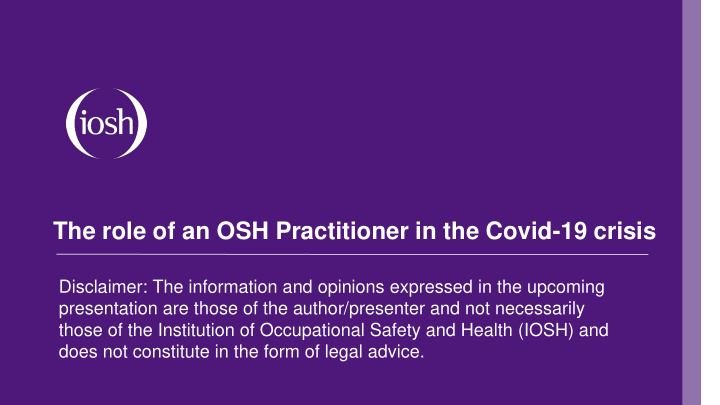



The role of an OSH Practitioner in the Covid-19 crisis Disclaimer: The information and opinions expressed in the upcoming presentation are those of the author/presenter and not necessarily those of the Institution of Occupational Safety and Health (IOSH) and does not constitute in the form of legal advice.
Introduction Your hosts today Duncan Spencer Head of Advice & Practice Louise Hosking IOSH Vice-President Jonathan Hughes IOSH Vice-President
Introduction Today we will discuss three important areas and how that relates to the role of the OSH practitioner during and recovering from the Covid-19 crisis. Workplace & Legislative Compliance OSH Human Management Factors & Systems Behaviours
Workplace & Legislative Compliance
Pitfalls & Challenges Compliance and even advising on performing beyond compliance remains a concern for the OSH practitioner - Will there be a change to OSH legislation? - How will operational practice change in your organisation and what does that mean for the existing OSH risk portfolio? - Do OSH laws still apply during disrupted working i.e. lockdown or phased return? - How do you manage placing workers to infill gaps and temporary workers? - Can we expect legislative change in the future?
OSH Management Systems
Being risk-led and evidence driven The design of a safety management system is dependent on the risks that need to be managed, organisational structure and operational policies Risk assessment is a vital tool to justify decisions and actions - Do you understand the biology of the virus and how it may be transmitted/spread? - Have you identified the activities and locations where the likelihood of transmission is increased? - Have you employed the hierarchy of risk control to develop a control strategy? - Does your risk control strategy include identifying workers with the disease and social distancing?
Other control considerations Other parameters to consider: prevention and recovery controls are central to the OSH practitioners purpose - Accommodating workers in offices on production lines and maintaining social distancing - Repurposing rooms - Staggering start and finish times to reduce pressure on lift systems - Use of stairways - Cleaning hot desking between use - Maintaining home working - Phased return of workers - Opening up shut down buildings - Statutory checks and controls e.g. Legionella, fire systems - Developing new cleaning regimes - Increasing hand cleansing facilities - Business continuity - Loss of critical person - Dealing with future waves of infection - Security of supply chain and contractor service
Systems considerations In the phased return to work the OSH management systems may not be able to operate as normally: the OSH practitioner needs to be agile and flexible Consider: - For BAU OSH risk where can control be relaxed or achieved differently: where must it not be compromised? - How will COVID- 19 response be incorporated into the organisation’s governance arrangements? What reports must go to the Board? - Has your business continuity plans been reviewed to incorporate what you have learnt? Do plans include covering the loss of key Directors and other critical roles? Will they be in better shape if there are future spikes of infection? - Does your wellbeing system adequately cover the mental ill-health risk arising from COVID-19? - What are the financial implications of more cleaning and how are cleaners to be better protected considering their potentially heightened exposure?
Recruitment & Competence Employees may need retraining and redeploying, temporary workers may need inducting, contractors will still be needed to work in your premises The OSH practitioner must still advise on competency - How do you keep up to date with the daily changing information on the pandemic? - What do workers need to know, what do they need to do? - How will you ensure that first line managers know how to supervise effectively in these new working conditions? - How do you discuss controlling the Covid-19 risk with contractors? Their risk to you, your risk to them and combination of activity that may bring new risks to both? - How do you deal with Covid-19 myths? - What operational risks may change and intensify e.g. key workers exposed to violent public worried about them spreading the disease?
Human Factors & Behaviours
Changing Perceptions The science of persuading employees to work safely is key to the OSH practitioners role - How do you monitor and react appropriately to changes in behaviour, attitude, belief and motivation caused by the pandemic? - The pandemic is forcing new working arrangements that may well become the new normal post-pandemic e.g. virtual working: what are the implications for risk and Osh management systems? - What do you have to do, who must your regularly communicate with and what do you say to stay the organisations trusted advisor and critical friend? - Many workers will be anxious or even depressed after being furloughed or working from home: what must be done to support them and rehabilitate in the workplace? - Society, its citizens, our workers may demand that all businesses become health focussed businesses: to depend on adherence to collective behavioural expectations. What are the implications, what new things will you now need to think about and do?
Panel Q&A Post your questions to our panel: Duncan Spencer Head of Advice & Practice Louise Hosking IOSH Vice-President Jonathan Hughes IOSH Vice-President
The role of the OSH practitioner in the Covid-19 crisis IOSH Webinar Post Webinar: Please visit: https://www.iosh.com/coronavirus/webinar for post webinar resources Please email: ioshwebinarsfeedback@iosh.com to submit comments and further feedback.
Recommend
More recommend